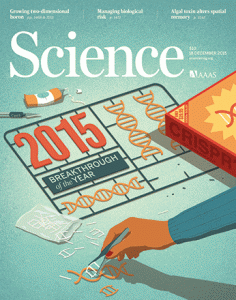 Science has retracted an August paper on an interesting electric current researchers observed in a kind of material called a topological insulator. Well, a current the researchers — based at Stanford and MIT — thought they had observed.
Science has retracted an August paper on an interesting electric current researchers observed in a kind of material called a topological insulator. Well, a current the researchers — based at Stanford and MIT — thought they had observed.
A magnetic field with particular attributes reported in the paper seemed to provide evidence of the current. But the researchers soon discovered that the field might have been, in part, an artifact of the very device they used to detect it. The authors, along with a few other researchers, have published that subsequent finding on the physics preprint server, arXiv.
Here’s the retraction note:
In the Report “Observation of chiral currents at the magnetic domain boundary of a topological insulator” (1), we reported the observation of a chiral current in a topological insulator/ferromagnetic insulator heterostructure. The measurement used a superconducting quantum interference device (SQUID) to detect an ac magnetic field that we believed was produced by a current flowing in the sample. Depending on the conductivity of various layers of the sample, a similar signal can arise when electric coupling causes a vertical oscillation of the SQUID in the spatially varying magnetic field produced by the magnetism of the sample. We and collaborators have subsequently shown that the magnitude, shape, frequency dependence, and backgate-voltage dependence of the signal can be explained by the electric coupling artifact (2). Although this does not rule out the presence of chiral edge states in these samples, we cannot state that we have observed them. Thus, we must retract our results. This artifact does not affect other papers that used similar methods to image current in nonmagnetic samples.
The paper has been cited once, according to Thomson Scientific’s Web of Knowledge.
Marcia McNutt, the Editor in Chief of Science, told us that the authors first contacted Science on September 25, a little over a month after the paper was published:
[Kathryn Moler, the last author] contacted the editor who handled the paper to say they might have to correct/retract their paper because they suspected that their original interpretation of the data was incorrect. They said that they were investigating and would be in touch again.
McNutt also told us:
At no time was there a concern about misconduct.
Meanwhile this retraction gets a “doing the right thing” nod, for the authors acting so quickly and transparently to correct the record.
Update, 12/24, 9:45 EST: Moler got back to us with more information. We asked her how the problem with the paper came to light:
Our collaborator Eric Spanton, a senior student in my lab, was the first to figure out that the effect was due to the electric coupling artifact. Eric and another student, Aaron Rosenberg, were continuing the line of measurements from the Science paper that has now been retracted. Eric realized that the frequency dependence was better explained by the artifact. We subsequently described a full body of relevant evidence in our arXiv paper.
It still seems like a real possibility. There are ways to avoid the artifact, but obviously any future work has to be pretty cautious on this point.
With hindsight, we could have been more self-critical and questioning in the original data analysis, and checked the dependence of the signal on more parameters.
Like Retraction Watch? Consider making a tax-deductible contribution to support our growth. You can also follow us on Twitter, like us on Facebook, add us to your RSS reader, and sign up on our homepage for an email every time there’s a new post. Click here to review our Comments Policy.